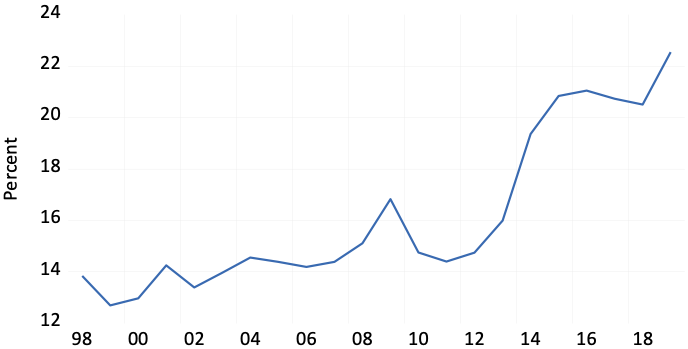| Author Name | Willem THORBECKE (Senior Fellow, RIETI) |
|---|---|
| Research Project | East Asian Production Networks, Trade, Exchange Rates, and Global Imbalances |
| Download / Links |
This Non Technical Summary does not constitute part of the above-captioned Discussion Paper but has been prepared for the purpose of providing a bold outline of the paper, based on findings from the analysis for the paper and focusing primarily on their implications for policy. For details of the analysis, read the captioned Discussion Paper. Views expressed in this Non Technical Summary are solely those of the individual author(s), and do not necessarily represent the views of the Research Institute of Economy, Trade and Industry (RIETI).
Macroeconomy and Low Birthrate/Aging Population (FY2020-2023)
East Asian Production Networks, Trade, Exchange Rates, and Global Imbalances
Shinzo Abe became Japanese prime minister at the end of 2012 and unveiled an economic program known as Abenomics. One pillar of this program called on the Bank of Japan to print unlimited quantities of yen to reach its inflation target. The Japanese yen subsequently depreciated by 45% against the U.S. dollar. How did changes in the yen during this period affect the Japanese economy?
The Japanese yen had appreciated by almost 50% against the U.S. dollar between the middle of 2007 and the beginning of 2012. Sato and Shimizu (2015) noted that Japanese firms may have responded to the soaring yen by transferring production of low-value added products to subsidiaries abroad and by producing only differentiated and high-value-added products in Japan. The depreciation of the yen starting in 2012 may then have impacted Japanese firms differently after firms had taken these steps than it would have before. If Japanese firms exported higher-value-added products after 2012, their pricing behavior could have changed (Sato and Shimizu, 2015). These differentiated products may be more competitive abroad, and Japanese firms may have had greater ability to price-to-market (i.e., keep foreign currency prices constant) when the yen depreciated. In this case, their profit margins rather than their export volumes would increase. In addition, repatriated earnings from outsourced production would be worth more in yen terms when the yen depreciated and this would increase the profitability of Japanese firms.
Japanese firms not only compete with foreign firms, but also cooperate with them by purchasing parts and components, primary goods, and capital goods from overseas. When the yen depreciates, Japanese firms can either purchase less of these inputs, purchase the same quantity at higher costs, or purchase lower quality imported inputs. Any of these should harm domestic firms.
If Japanese firms are competing with foreign firms, then a yen depreciation should increase their profitability. If they are cooperating by purchasing imported inputs, then a depreciation should decrease their profitability. Since finance theory indicates that stock prices equal the expected present value of future cash flows, the response of stock prices to exchange rate changes can shed light on whether they were cooperating or competing after the advent of Abenomics. If they are both competing and cooperating, the response of stock prices to exchange rates can indicate which of these effects predominate.
This paper uses two methods to investigate how exchange rate changes after 2012 affected Japanese industries. First it estimates export and import functions ending in both 2012 and 2018. For the estimates ending in 2012, it employs actual out-of-sample values of the explanatory variables to examine how exports and imports would be expected to respond and compares this with the actual responses. Second, it estimates sectors' stock market exposures to exchange rates for the period before 2013 and for the 2013-2018 period.
The results indicate that goods exports are much less than predicted for many key sectors such as transportation equipment during the latter depreciation period. Services exports, on the other hand, soared following the depreciation. Figure 1 shows that the share of services in Japan's exports increased from 14.7 percent in 2012 to 22.5 percent in 2019. The findings also indicate that the depreciations raised profitability for key manufacturing sectors such as transportation equipment. This indicates that responses that corporate Japan made to swings in the yen such as transferring production abroad have been good for profitability. However, the large drop in exports compared to what would be expected indicates that the weaker yen had a diminished effect on Japanese manufacturing output and employment.

- Reference(s)
-
- Sato, K., and Shimizu, J. (2015). Abenomics, Yen Depreciation, Trade Deficit, and Export Competitiveness (RIETI Discussion Paper Series 15-E-020), Tokyo: Research Institute of Economy, Trade and Industry.

